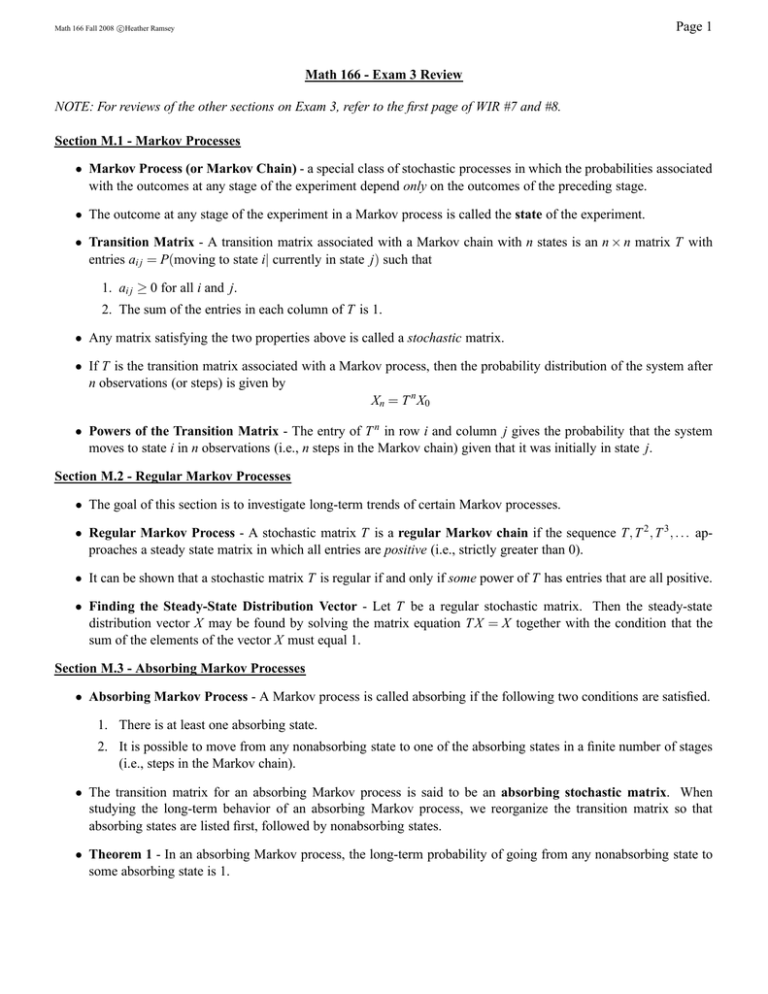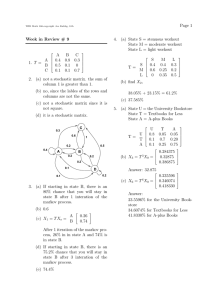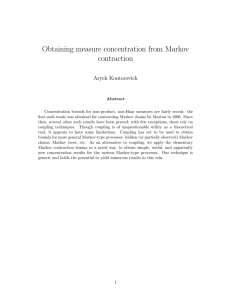Document 10496140
advertisement

Page 1 c Math 166 Fall 2008 Heather Ramsey Math 166 - Exam 3 Review NOTE: For reviews of the other sections on Exam 3, refer to the first page of WIR #7 and #8. Section M.1 - Markov Processes • Markov Process (or Markov Chain) - a special class of stochastic processes in which the probabilities associated with the outcomes at any stage of the experiment depend only on the outcomes of the preceding stage. • The outcome at any stage of the experiment in a Markov process is called the state of the experiment. • Transition Matrix - A transition matrix associated with a Markov chain with n states is an n × n matrix T with entries ai j = P(moving to state i| currently in state j) such that 1. ai j ≥ 0 for all i and j. 2. The sum of the entries in each column of T is 1. • Any matrix satisfying the two properties above is called a stochastic matrix. • If T is the transition matrix associated with a Markov process, then the probability distribution of the system after n observations (or steps) is given by Xn = T n X0 • Powers of the Transition Matrix - The entry of T n in row i and column j gives the probability that the system moves to state i in n observations (i.e., n steps in the Markov chain) given that it was initially in state j. Section M.2 - Regular Markov Processes • The goal of this section is to investigate long-term trends of certain Markov processes. • Regular Markov Process - A stochastic matrix T is a regular Markov chain if the sequence T, T 2 , T 3 , . . . approaches a steady state matrix in which all entries are positive (i.e., strictly greater than 0). • It can be shown that a stochastic matrix T is regular if and only if some power of T has entries that are all positive. • Finding the Steady-State Distribution Vector - Let T be a regular stochastic matrix. Then the steady-state distribution vector X may be found by solving the matrix equation T X = X together with the condition that the sum of the elements of the vector X must equal 1. Section M.3 - Absorbing Markov Processes • Absorbing Markov Process - A Markov process is called absorbing if the following two conditions are satisfied. 1. There is at least one absorbing state. 2. It is possible to move from any nonabsorbing state to one of the absorbing states in a finite number of stages (i.e., steps in the Markov chain). • The transition matrix for an absorbing Markov process is said to be an absorbing stochastic matrix. When studying the long-term behavior of an absorbing Markov process, we reorganize the transition matrix so that absorbing states are listed first, followed by nonabsorbing states. • Theorem 1 - In an absorbing Markov process, the long-term probability of going from any nonabsorbing state to some absorbing state is 1. Page 2 c Math 166 Fall 2008 Heather Ramsey • Theorem 2 (Tomastik and Epstein, pg. 350) - Let T be the transition matrix of an absorbing Markov process with a absorbing states and b nonabsorbing states. Reorder the states so that the first a of them are absorbing and the remaining b of them are nonabsorbing. Partition the matrix as follows: Ia×a Aa×b Ob×a Bb×b Then the following are true: 1. As n becomes large without bound, the matrix T n , which is the transition matrix from the initial stage to the nth stage, heads for the limiting matrix Ia×a A(I − B)−1 L= Ob×a Ob×b where the identity matrix I in the expression (I − B)−1 is the same dimension as B, that is, b × b. 2. The entry in the ith row and jth column of the sub-matrix A(I − B)−1 gives the probability that the system will end up in the ith absorbing state when initially in the jth nonabsorbing state. 3. All column sums of A(I − B)−1 are 1, and thus everything is expected to be absorbed. 1. True/False TRUE TRUE FALSE FALSE a) b) TRUE FALSE c) TRUE TRUE FALSE FALSE d) e) TRUE FALSE f) TRUE FALSE g) TRUE FALSE h) In A = AIn = A for all matrices A. When using rref in the calculator, a row of all 0’s at the bottom of the resulting matrix guarantees that the system of equations has infinitely many solutions. To be able to compute the matrix product AB, the number of columns of A must equal the number of rows of B. If B is a 2 × 2 matrix, then B + I2 = B. If T is a 3 × 3 transition matrix, then t13 represents the probability of going to state 3 next if currently in state 1. If in solving a system of equations inthe variablesx and y using the Gauss1 0 3 , then the system of equaJordan elimination method you obtain 0 1 8 tions has only one solution. If the parametric solution to a system of equations is (3t + 2, −t − 3,t), then (−7, 0, −3) is a particular solution. If A is a 3 × 4 matrix and B is a 2 × 4 matrix, then BAT is a 2 × 3 matrix. 2. For the next two word problems do the following: I) Define the variables that are used in setting up the system of equations. II) Set up the system of equations that represents this problem. III) Solve for the solution. IV) If the solution is parametric, then tell what restrictions should be placed on the parameter(s). Also give three specic solutions. (a) Fred, Bob, and George are avid collectors of baseball cards. Among the three of them, they have 924 cards. Bob has three times as many cards as Fred, and George has 100 more cards than Fred and Bob do combined. How many cards do each of the friends have? (b) In a laboratory experiment, a researcher wants to provide a rabbit with exactly 1000 units of vitamin A, exactly 1600 units of vitamin C and exactly 2400 units of vitamin E. The rabbit is fed a mixture of three Page 3 c Math 166 Fall 2008 Heather Ramsey foods. Each gram of food 1 contains 2 units of vitamin A, 3 units of vitamin C, and 5 units of vitamin E. Each gram of food 2 contains 4 units of vitamin A, 7 units of vitamin C, and 9 units of vitamin E. Each gram of food 3 contains 6 units of vitamin A, 10 units of vitamin C, and 14 units of vitamin E. How many grams of each food should the rabbit be fed? 3. Solve the system 5x − 3y 2x + 6y = = 7 using the Gauss-Jordan elimination method. (See WIR #7 for an example with −1 three equations and three unknowns.) 4. Solve for the variables x, y, z, and u. If this is not possible, explain why. 2 x 0 −1 1 y+1 4 z + 7 z 0 x T = −2 1−u −3 5 − 23 5. A small town has only two dry cleaners, Acme Dry Clean, and Emca Dry Cleaners. Acme’s manager hopes to increase the firm’s market share by conducting an extensive advertising campaign. After the campaign, a market research firm finds that 65% of Acme’s customers will return to Acme Dry Clean with their next load of dry cleaning, and 25% of Emca’s customers will switch to Acme for their next load of dry cleaning. Suppose that each customer brings one load of dry cleaning per week and that before the ad campaign, 35% of all customers used Acme Dry Clean and 65% of all customers used Emca Dry Cleaners. (a) What is the transition matrix for this Markov process? If this is an absorbing Markov process, order the states so that all absorbing states are listed first. (b) What will the percentages of the market share look like 4 weeks after the advertising campaign? Give your answer as percentages rounded to 2 decimal places. (c) What is the probability that an individual who initially took his or her dry cleaning to Acme Dry Clean will then take his or her dry cleaning to Emca Dry Cleaners one week after the ad campaign begins? (d) What is the probability that someone who initially took his or her dry cleaning to Emca Dry Cleaners will take a load of dry cleaning to Emca six weeks after the ad campaign begins? (e) Is this a regular Markov process or an absorbing Markov process? If regular, find the steady-state distribution vector for this Markov process. If absorbing, determine the long-term behavior of this Markov process. If neither, explain why. 6. Use the given matrices to compute each of the following. If an operation is not possible, explain why. A= −5 7 1 3 , B= 5 8 3 2 5 −8 , C = 6 5 4 −3 7 1 (a) B +C (b) BC (c) ABT − 5C (d) CA 7. (Inspired by Application 2, pg. 40 of Linear Algebra with Applications, 5th ed., by Steven J. Leon) A company manufactures three products: A, B, and C. Its production expenses per item are summarized in the first table below. The second table gives the number of each type of product produced in each quarter of 2007. Page 4 c Math 166 Fall 2008 Heather Ramsey Production Costs Per Item (in dollars) Product Expenses A B C Materials 20 26 17 Assembly 12 15 10 Packaging 2 1 2 Quantity Produced Each Quarter Quarter Product 1 2 3 4 A 350 375 370 365 B 320 290 275 250 C 485 410 415 390 Write two matrices C and Q summarizing the above information and show how matrix multiplication can be used to produce a matrix that gives the total costs for each type of expense for each quarter. 8. (adaptation of #11, pg. 427 of Finite Mathematics and its Applications, 9th ed, by Goldstein, Schneider, and Siegel) A group of physical fitness devotees works out in the gym every day. The workouts vary from strenuous to moderate to light. When their exercise routine was recorded, the following observation was made: Of the people who work out strenuously on a particular day, 40% will work out strenuously the next day, 45% will work out moderately the next day, and the rest will do a light workout the next day. Of the people who work out moderately on a particular day, 50%, 30% and 20% will work out strenuously, moderately, and lightly (respectively) the next day. Of the people working out lightly on a particular day, 45%, 30% and 25% will work out strenuously, moderately, and lightly (respectively) the next day. (a) Write the transition matrix for this Markov process. If this is an absorbing Markov process, order the states so that all absorbing states are listed first. (b) What is the probability that a person who did a strenuous workout on Tuesday will do a light workout on Friday (same week)? (c) Suppose that on a particular Monday 80% do a strenuous workout, 10% do a moderate workout, and 10% do a light workout. What will the percentages for each type of workout look like on Wednesday of the following week? (d) Is this a regular Markov process or an absorbing Markov process? If regular, find the steady-state distribution vector for this Markov process. If absorbing, determine the long-term behavior of this Markov process. If neither, explain why. 9. Solve the following systems of equations. If there are infinitely many solutions, state so and give the parametric solution. If there is no solution, state so. (a) −3x y−7 2x + z (b) 9x + 2y − 6z 3x − y − 2z −3x − 4y + 2z 6x − 2y − 4z (c) 2x − y 6x − 3y + 4z = = = 4y + z −x + 5z 14 − y = = = = = = 2 7 15 17 −7 −20 10. Determine whether each of the following is the transition matrix for a regular Markov process, an absorbing Markov process, or neither. If the transition matrix is for an absorbing Markov process, reorder the states so that all abosorbing states are first, and then find the limiting matrix. 0 0.7 0.3 (a) 1 0.2 0.1 0 0.1 0.6 Page 5 c Math 166 Fall 2008 Heather Ramsey 0 1 0 (b) 0 0 1 1 0 0 0.3 0 0 0.6 0.1 1 0 0 (c) 0.1 0 1 0 0.5 0 0 0.4 11. (Adapted from #12, pg. 450 of Finite Mathematics and its Applications, 9th ed, by Goldstein, Schneider, and Siegel) The figure below gives the layout of a house with four rooms connected by doors. Room 1 contains a (live) mousetrap, and Room 2 contains cheese. A mouse, after being placed in either Room 3 or 4, will search for cheese; if unsuccessful after two minutes, it will exit to another room by selected one of the doors at random. A mouse entering Room 1 will be trapped and therefore no longer move to other rooms. Also, a mouse entering Room 2 will remain in that room. Room 2 (cheese) Room 3 Room 1 (trap) Room 4 (a) Write the transition matrix for this Markov process. If this is an absorbing Markov process, order the states so that all absorbing states are listed first. (b) If a mouse begins in Room 3, what is the probability that it will find the cheese after 8 minutes? (c) Determine the long-term behavior of this Markov process by finding the limiting matrix and explaining the meaning of its entries.






